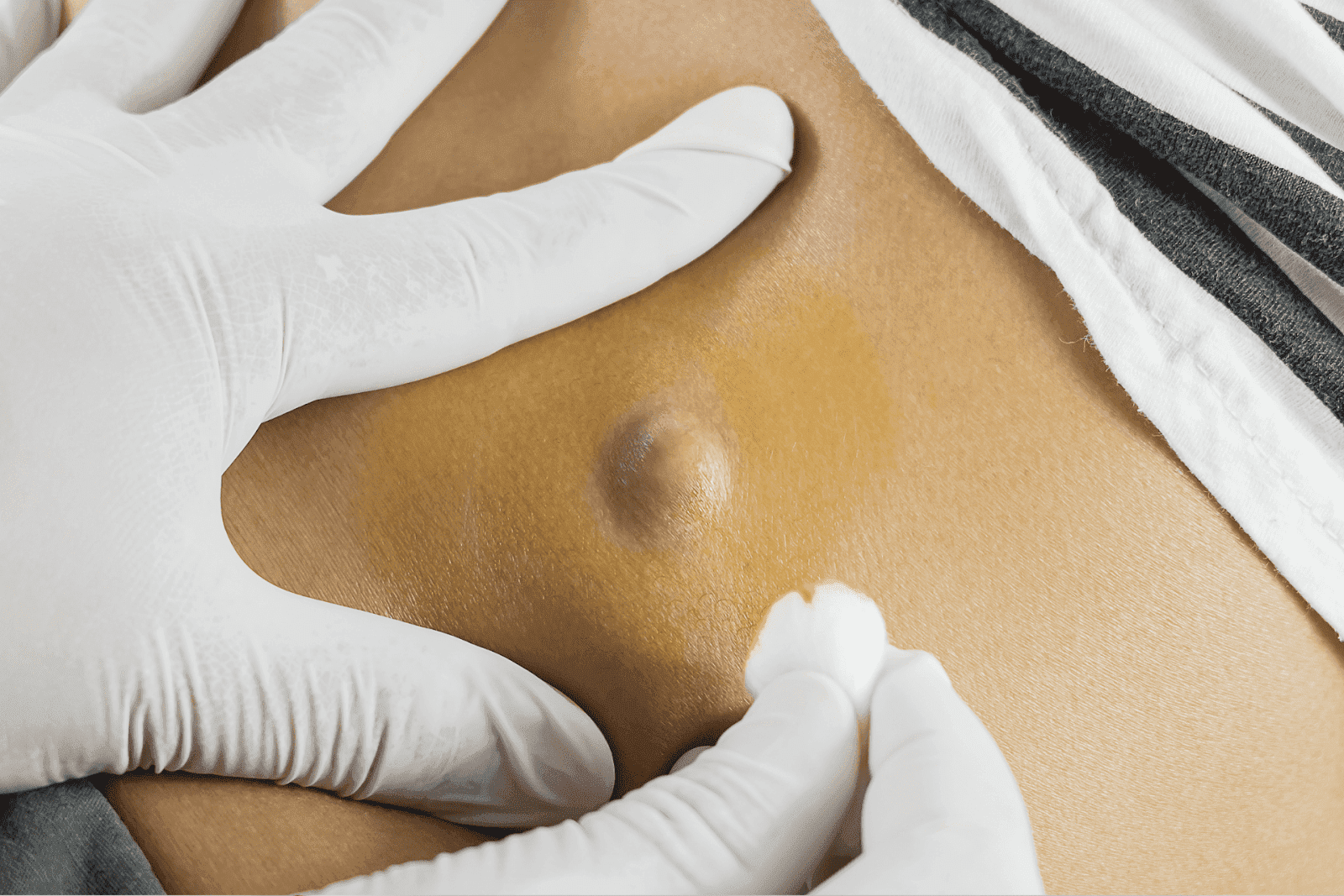Does Gabapentin Help with Sciatica?
Sciatica can cause sharp pain that shoots down your leg, making simple tasks hard. Many people wonder if gabapentin, a common medication, can ease this pain. This article [...]
Read More
Medically reviewed by Abhijit Bhattacharyya | MD, PhD, MBA, Tufts University School of Medicine - Miami, Florida on August 19th, 2025.
Discovering a lump on the back can be alarming. While many lumps are benign and harmless, others require medical evaluation and sometimes treatment. This article walks through the most common possibilities, how to tell which lumps may be more concerning, what to expect during evaluation, and practical next steps, including how to get fast, affordable telehealth care through Doctronic.ai when immediate guidance is needed.
Lumps are simply areas where tissue has changed in size, density, or structure. That change could be due to fat, fluid, inflammation, infection, scar tissue, or abnormal cell growth. The back has skin, fat, muscle, lymph nodes in certain regions, and connective tissue, all of which can give rise to a palpable lump.
Understanding the origin helps narrow down the cause. For example, a soft, movable lump just under the skin is more likely to be a lipoma (a benign fatty tumor), whereas a red, painful, warm lump could be an infected cyst or abscess. Lymph nodes can enlarge when fighting an infection. Less commonly, lumps on the back can represent malignant tumors that need prompt attention.
 Common Types of Lumps Found on the Back
Common Types of Lumps Found on the BackMost lumps on the back fall into a few well-known categories. Each has characteristic features that can be noted at home, though clinical evaluation and sometimes imaging or biopsy are required for definitive diagnosis.
Lipomas are benign growths composed of fat cells. They are usually soft, rubbery, and move easily under the skin when pressed. Lipomas are typically painless, slow-growing, and most often harmless. They can occur anywhere on the body where fat cells exist, including the back, and are common in adults between the ages of 40 and 60.
Also called epidermoid cysts, these are pockets of keratin and skin cells trapped beneath the skin. They often feel like a small, round bump with a central punctum (a tiny dark dot) and may become inflamed or infected, causing redness, pain, and drainage of thick, foul-smelling material. Cysts can change in size and do not move as freely as lipomas.
An abscess is a painful, swollen collection of pus caused by bacterial infection. It is typically red, warm, and tender, and the overlying skin may be shiny or stretched. Fever and feeling generally unwell can accompany an abscess. Proper medical drainage and antibiotics are often necessary, so prompt evaluation is important.
Lymph nodes can become enlarged as part of the immune response to infection or inflammation. On the back, prominent lymph nodes are less common than in the neck, armpit, or groin, but regional enlargement is possible. These nodes are usually small, firm, and may be tender if the body is fighting an infection.
Dermatofibromas are common benign fibrous nodules that can appear on the skin. They are usually small, firm, and may dimple when pinched. Other benign skin growths include keloids and hypertrophic scars that form after injury. These lesions are not cancerous but can be cosmetically bothersome.
Primary skin cancers like squamous cell carcinoma or melanoma can present as lumps or nodules. Soft tissue sarcomas or metastases from other cancers can also produce masses beneath the skin. Signs that raise concern include rapid growth, firmness, fixation to deeper tissues, irregular shape, ulceration, bleeding, or systemic symptoms like unexplained weight loss. Any suspicious features warrant prompt medical assessment and often imaging or biopsy.
While a home exam cannot replace a clinician’s evaluation, certain features help prioritize urgency. Perform a gentle assessment and note these characteristics for your healthcare provider:
Is the lump in the skin, just under the skin, or deep within the muscle? Superficial bumps that move easily are usually less worrisome than deep, fixed masses. Mark the location or take a photo to track changes over time.
Measure or compare to a coin. Sudden growth over days to weeks, or a lump that continues to expand over months, should prompt evaluation. Lipomas often grow slowly over the years, while infections may enlarge quickly.
Soft, squishy, and mobile lumps lean toward cysts or lipomas. Hard, fixed lumps may indicate scar tissue, fibrous tumors, or malignancy. Tenderness often suggests infection or inflammation.
Redness, warmth, ulceration, or drainage are signs of inflammation or infection. Pigmented changes or irregular surface markings could suggest a skin cancer and require a biopsy.
Fever, night sweats, unexplained weight loss, fatigue, or multiple lumps throughout the body are systemic signs that require prompt medical attention. Localized pain and functional limitation (e.g., restricted shoulder movement) also increase urgency.
Not all lumps require emergency treatment, but certain red flags indicate the need for urgent medical attention. Immediate evaluation is recommended if the lump is:
Rapidly growing or changing in appearance
Painful, red, warm, or draining pus
Causing fever or other systemic symptoms
Fixed to the underlying tissues or impairing movement
Accompanied by unexplained weight loss or night sweats.
An abscess with spreading redness, high fever, or severe pain often requires prompt drainage and antibiotics. Similarly, sudden, rapidly enlarging masses should be evaluated quickly to rule out aggressive infection or malignancy.
Small, painless, slow-growing lumps without systemic symptoms may be assessed in outpatient clinics. Imaging, like ultrasound or MRI, and sometimes a biopsy, can provide a definitive diagnosis. For convenience and speed, telehealth can be an excellent first step to get expert guidance and a plan.
Clinicians use a combination of physical exam, imaging, and lab tests to identify the cause of a back lump. The specific workup depends on the suspected diagnosis.
Palpation helps determine size, depth, mobility, tenderness, and relation to surrounding structures. Skin inspection notes color changes, puncta, or sinus tracts. The clinician will ask about onset, growth, prior trauma, and general health.
Ultrasound is often the first imaging test for superficial lumps. It distinguishes cystic from solid masses, evaluates vascularity, and guides needle aspiration or biopsy. MRI offers detailed views of deep soft tissue masses and helps delineate the involvement of muscles or bones. CT scans may be used in certain circumstances for further characterization.
A fine-needle aspiration or core needle biopsy can obtain tissue for pathology without removing the entire lump. For many benign lesions or symptomatic cysts, surgical excision both diagnoses and treats the lesion. Any suspicious or growing mass is usually biopsied to rule out cancer.
Treatment ranges from watchful waiting to surgery, antibiotics, or specialized oncology care, depending on the underlying cause.
Asymptomatic lipomas or small benign lumps may be observed if they are not growing or causing problems. Regular monitoring and photos can track any changes.
Excision is the definitive treatment for symptomatic lipomas, cysts, or lesions causing cosmetic concern. Minor outpatient procedures often fully remove the mass with low recurrence risk for many benign lesions.
Infected cysts or abscesses usually need incision and drainage combined with appropriate antibiotics. Drainage provides symptomatic relief and reduces the risk of deeper infection.
If a malignancy is diagnosed, treatment may include surgery, radiation, chemotherapy, or targeted therapy, depending on the tumor type and staging. Early specialist referral improves outcomes.
Gathering clear information beforehand helps clinicians provide faster, more accurate recommendations. Valuable items include photos, a timeline of changes, a list of symptoms, and past medical history, including any previous lumps or family history of cancers.
Take photos from multiple angles and note dates to show growth rate. Write down when the lump was first noticed and any events such as trauma or infection. This documentation can be invaluable during a telehealth visit or clinic appointment.
Ask about the likely cause, recommended tests, urgency of evaluation, signs that should prompt immediate attention, and treatment options. Understanding the next steps helps reduce anxiety and ensures appropriate follow-up.
Many people want quick answers before booking an in-person visit. Telehealth platforms can offer triage, visual assessment, and a plan for evaluation. Doctronic is highlighted for fast AI-powered triage and inexpensive video visits with licensed clinicians across all 50 states.
Doctronic.ai offers free AI doctor visits on its website, providing anyone with an initial assessment and written guidance. For a more complete evaluation, Doctronic also offers telehealth video visits with real doctors for under $40, available 24/7. This combination enables rapid advice, whether the lump appears clearly benign or needs urgent in-person care.
Doctronic blends AI-driven synthesis of peer-reviewed medical knowledge with human clinician availability. The AI doctor can quickly summarize probable causes, suggest immediate home care steps, and recommend whether an urgent in-person evaluation is warranted. If needed, a follow-up video visit with a human physician can be scheduled promptly to guide next steps, order imaging, or refer for surgical consultation.
Because Doctronic’s system remembers patient history over time and integrates the latest medical research, it offers personalized, fast, and evidence-based guidance. This is particularly useful when monitoring a lump’s changes over weeks or when seeking a second opinion without delay. Visit doctronic.ai for the free AI assessment or to schedule a low-cost video visit.
 Home Care While Awaiting Evaluation
Home Care While Awaiting EvaluationFor lumps that appear non-urgent, simple measures can be taken at home while awaiting evaluation. Avoid squeezing or trying to lance a lump. Keeping the area clean and monitoring for signs of infection is generally appropriate.
Warm compresses applied several times daily can help an inflamed cyst or abscess, but will not replace drainage if pus collects. If there is increasing redness, spreading streaks, fever, or severe pain, seek urgent care.
Over-the-counter pain relievers like acetaminophen or ibuprofen can be used for discomfort, unless contraindicated. Topical antiseptics may be applied if the skin is broken, but avoid any home attempts at incision.
Seek urgent care or telehealth evaluation right away if the lump is associated with any of the following:
Rapid enlargement over days or weeks
Severe pain, heat, or spreading redness
Fever or systemic symptoms
Bleeding, ulceration, or drainage that won’t stop
Loss of function (e.g., limited shoulder movement) or neurological symptoms like numbness.
While many lumps on the back are benign, distinguishing features should guide the urgency of evaluation. Note the lump’s size, growth, texture, mobility, skin changes, and any systemic symptoms. Photo documentation and a timeline are valuable.
For fast, evidence-based guidance and convenient access to clinicians, Doctronic.ai offers a free AI assessment and low-cost telehealth video visits nationwide. Telehealth can help triage the lump, suggest immediate care, and coordinate in-person evaluation or imaging if needed. For more details and to get an initial assessment, visit Doctronic.ai.
Remember that this article provides general information and is not a substitute for professional medical advice. When in doubt, seek clinical evaluation promptly.
If you’re worried about a lump on your back, skip the wait and get an evidence-based assessment right away from Doctronic, the #1 AI Doctor. Our AI visit is free and delivers a fast, peer-reviewed summary of likely causes and next steps. You can then book an inexpensive (<$40) 24/7 video visit with a licensed clinician in all 50 states if needed. Trusted by over 10 million people and headquartered in NYC, Doctronic remembers your history and gives personalized recommendations so you can act with confidence. Skip the line. Talk to an AI Doctor Now, for free.
Sciatica can cause sharp pain that shoots down your leg, making simple tasks hard. Many people wonder if gabapentin, a common medication, can ease this pain. This article [...]
Read MoreBack pain is one of the most common health complaints, affecting millions of people worldwide. If you have back pain, you might have heard about gabapentin as a possible [...]
Read MoreIf you take gabapentin, you might wonder if it will show up on a drug test. This question matters for many people, whether it’s for work, sports, or legal reasons. Gabapentin [...]
Read More